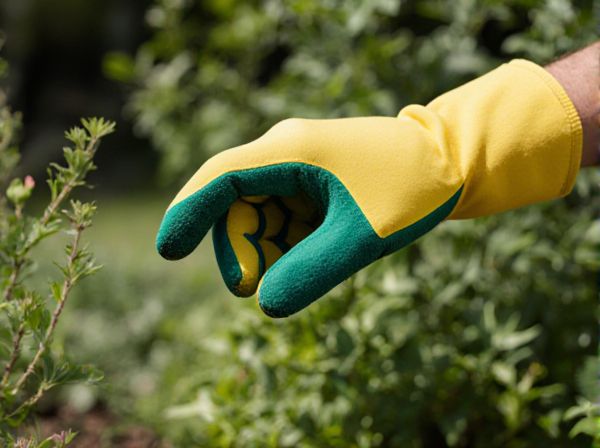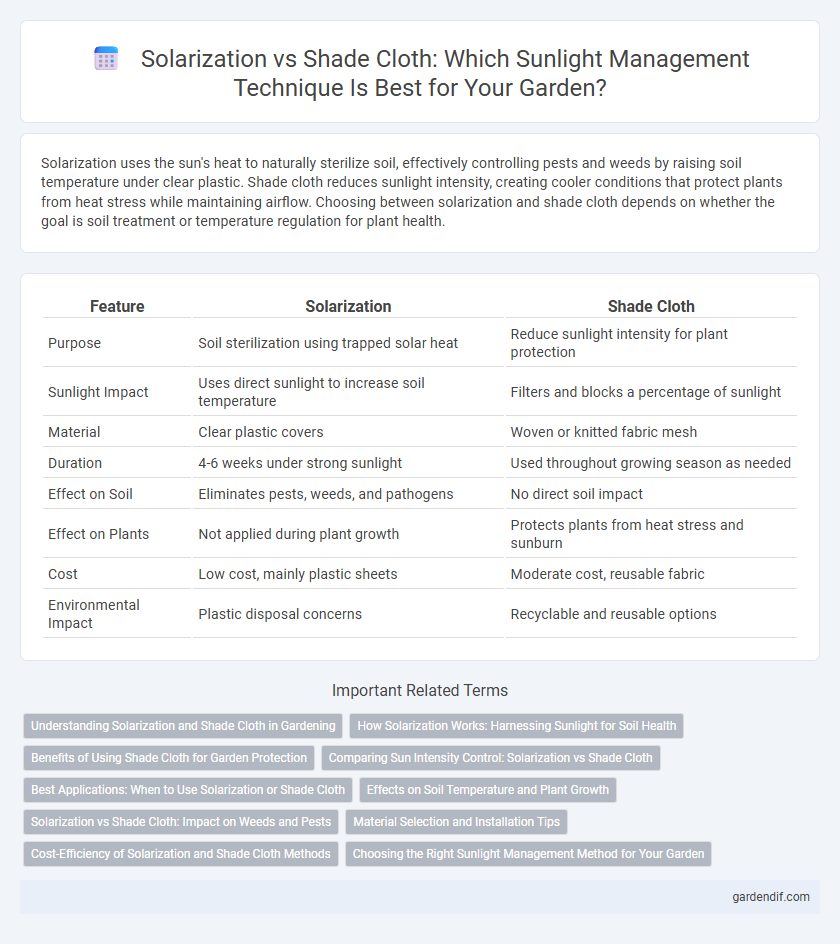
Solarization vs shade cloth Illustration
Solarization uses the sun's heat to naturally sterilize soil, effectively controlling pests and weeds by raising soil temperature under clear plastic. Shade cloth reduces sunlight intensity, creating cooler conditions that protect plants from heat stress while maintaining airflow. Choosing between solarization and shade cloth depends on whether the goal is soil treatment or temperature regulation for plant health.
Table of Comparison
| Feature | Solarization | Shade Cloth |
|---|---|---|
| Purpose | Soil sterilization using trapped solar heat | Reduce sunlight intensity for plant protection |
| Sunlight Impact | Uses direct sunlight to increase soil temperature | Filters and blocks a percentage of sunlight |
| Material | Clear plastic covers | Woven or knitted fabric mesh |
| Duration | 4-6 weeks under strong sunlight | Used throughout growing season as needed |
| Effect on Soil | Eliminates pests, weeds, and pathogens | No direct soil impact |
| Effect on Plants | Not applied during plant growth | Protects plants from heat stress and sunburn |
| Cost | Low cost, mainly plastic sheets | Moderate cost, reusable fabric |
| Environmental Impact | Plastic disposal concerns | Recyclable and reusable options |
Understanding Solarization and Shade Cloth in Gardening
Solarization uses clear plastic to trap solar heat and UV radiation, effectively sterilizing soil by killing pests, weeds, and pathogens. Shade cloth reduces sunlight intensity by blocking a specific percentage of sunlight, protecting plants from heat stress and sunburn while maintaining airflow. Understanding these methods helps gardeners optimize plant growth by choosing soil sterilization with solarization or temperature and light control with shade cloth.
How Solarization Works: Harnessing Sunlight for Soil Health
Solarization uses direct sunlight to raise soil temperature, effectively eliminating pathogens, weeds, and pests by converting solar energy into heat. This natural method increases soil temperature to levels between 45-60degC (113-140degF), enhancing microbial activity and nutrient availability for healthier plant growth. Unlike shade cloth, which reduces sunlight and lowers temperature, solarization maximizes sunlight exposure to improve soil health and crop yield.
Benefits of Using Shade Cloth for Garden Protection
Shade cloth provides effective protection from intense sunlight, reducing leaf scorch and water evaporation in garden plants. It creates a controlled environment by filtering harmful UV rays, enhancing plant growth and preventing heat stress. Unlike solarization, shade cloth allows persistent airflow and moisture retention, promoting healthier soil and plant development.
Comparing Sun Intensity Control: Solarization vs Shade Cloth
Solarization controls sun intensity by using transparent plastic sheets that trap heat and increase soil temperature, enhancing pest and weed control while maintaining high light exposure for plants. Shade cloth reduces sun intensity by filtering sunlight through woven or knitted fabrics, creating a cooler environment that protects plants from excessive heat and UV radiation. Both methods effectively manage solar radiation, but solarization intensifies heat for soil treatment, whereas shade cloth primarily moderates light and temperature for plant growth.
Best Applications: When to Use Solarization or Shade Cloth
Solarization is best applied for soil disinfection during warm, sunny periods to eliminate pests and pathogens by trapping solar heat. Shade cloth is ideal for protecting plants from excessive sunlight and heat during peak summer months, reducing stress and preventing sunburn. Use solarization before planting to improve soil health, and apply shade cloth during active growth phases for optimal plant protection.
Effects on Soil Temperature and Plant Growth
Solarization uses solar heat to increase soil temperature up to 45-65degC, effectively killing soil pathogens and weed seeds, which enhances plant growth and crop yields. Shade cloth reduces soil temperature by 5-10degC, protecting plants from heat stress but potentially slowing growth in cooler climates. Choosing between solarization and shade cloth depends on desired soil temperature regulation and specific crop requirements for optimal growth.
Solarization vs Shade Cloth: Impact on Weeds and Pests
Solarization harnesses intense solar heat by trapping sunlight beneath clear plastic, effectively raising soil temperatures to levels that kill weed seeds and soil-borne pests. Shade cloth reduces sunlight intensity, limiting photosynthesis for weeds but may not eliminate pests or their eggs as effectively as solarization. Solarization offers a more comprehensive solution for weed and pest control through thermal sterilization, whereas shade cloth primarily suppresses weed growth by limiting light exposure.
Material Selection and Installation Tips
Choosing between solarization and shade cloth depends on material durability and effectiveness; solarization uses clear polyethylene sheets that trap heat to sterilize soil, while shade cloth employs woven fabrics with specific UV ratings to control light exposure. For installation, solarization requires securing edges tightly to the ground to retain heat and moisture, whereas shade cloth demands robust frame support and proper tension to prevent sagging or wind damage. Selecting UV-resistant and weatherproof materials extends lifespan in both methods, enhancing garden protection and crop yield.
Cost-Efficiency of Solarization and Shade Cloth Methods
Solarization offers a cost-efficient approach by utilizing solar heat to control soil pathogens and weeds without recurring expenses beyond initial plastic sheeting investment. Shade cloth entails ongoing costs related to material purchase, installation, and potential replacement to manage light exposure and plant temperature. Comparing both, solarization minimizes long-term costs with natural energy use, while shade cloth provides adjustable protection but at higher maintenance expenses.
Choosing the Right Sunlight Management Method for Your Garden
Selecting the ideal sunlight management method depends on your garden's plant species and their sunlight tolerance, with solarization offering intense heat to eliminate soil pests and pathogens while shade cloth provides controlled light reduction to protect delicate plants from excessive sun exposure. Solarization is effective for preparing soil before planting by trapping solar heat under clear plastic, raising soil temperature to suppress weeds and soil-borne diseases. Shade cloth varieties come in different densities and colors, allowing tailored light filtration that helps maintain optimal photosynthesis rates and reduces heat stress for plants during peak sunlight hours.
Solarization vs shade cloth Infographic

 gardendif.com
gardendif.com